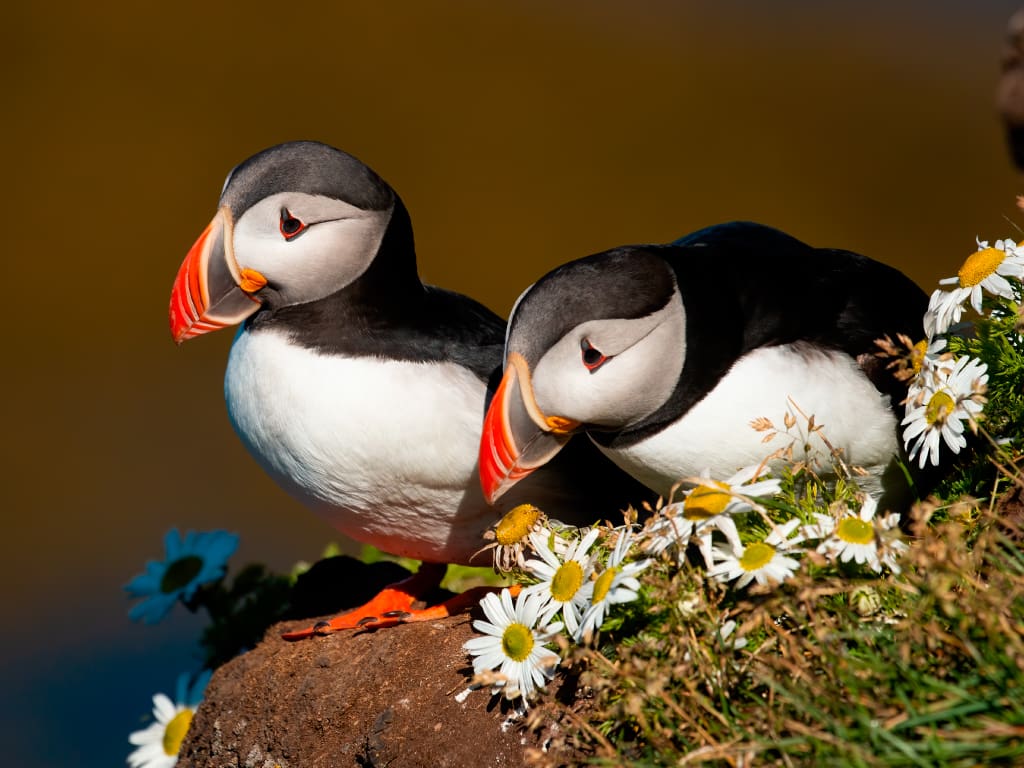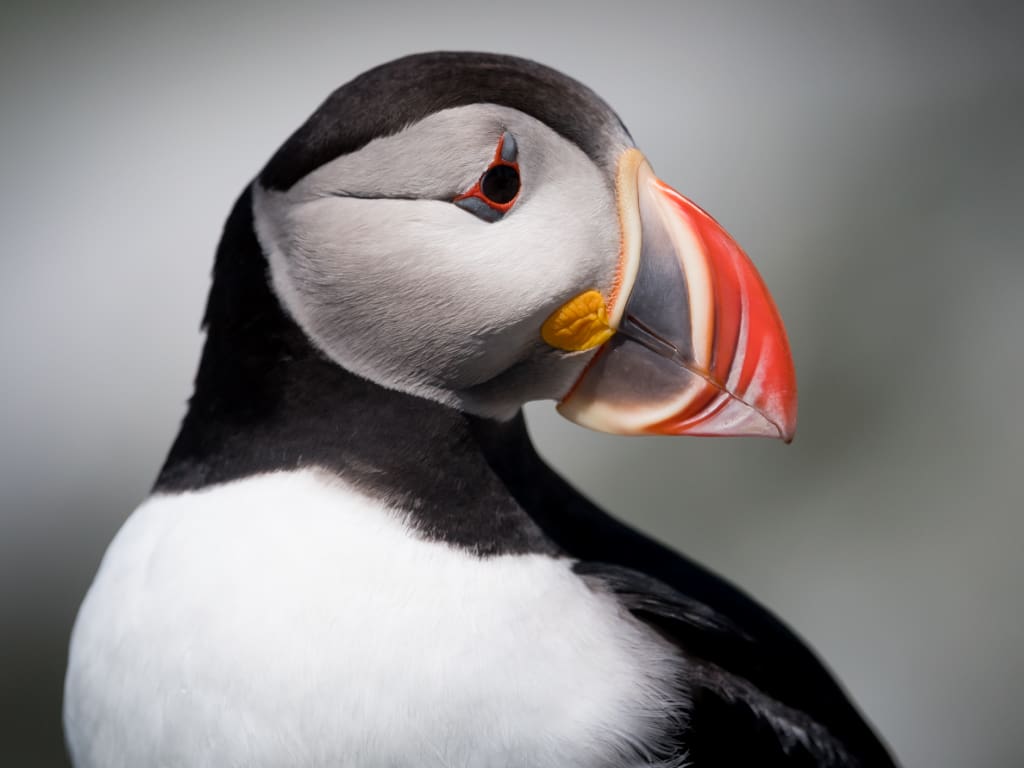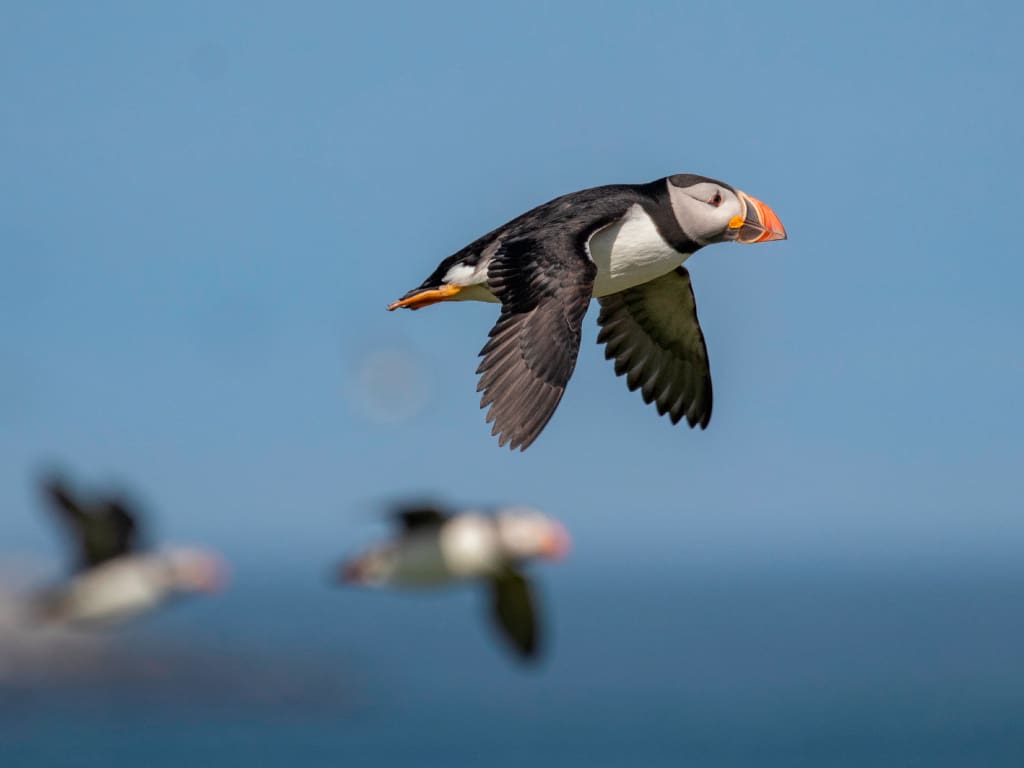Do you like puffins? We do! Here in the Westman Islands we are very proud of our connection to these little birds. The Westman Islands have the biggest puffin breeding colony in Iceland. Our history and culture is closely tied to these birds so they are a big part of our community’s heritage. The Westman Islands are only 8 miles off Iceland’s south coast so they are easy to get to if you are in the area.

Puffins are often mistaken for penguins because of their black and white feathers and upright stance. But puffins are not penguins. They belong to the Alcidae family which includes many seabirds in the northern hemisphere. Penguins are found in the southern hemisphere. Puffins are much smaller than penguins, about 30 cm (12 inches) long, 47-63 cm (18-25 inches) wingspan and 300-450 grams (10-16 ounces).
Despite their size puffins are strong and agile birds. Their small size allows them to fly and swim with surprising speed and agility. Their physical adaptations have evolved to fit their environment so well that they can thrive in the harsh North Atlantic.

One of the puffin’s most striking features is their beak. During the breeding season their beaks turn red and yellow stripes and blue near the base. This is part of their mating ritual to attract a mate. The colors fade after the breeding season and the outer plates of the beak are shed.
The puffin’s beak transformation is not just a biological wonder; it also serves a purpose. The colorful beak is a sign of maturity and health so the bird is ready to breed. This visual cue is important in the colonies where many puffins gather during the breeding season.

Puffins are known for their special flight pattern. Unlike many other birds, puffins have short wings in relation to their body size so they need to flap their wings fast to stay airborne. They can flap their wings up to 400 times per minute which makes them look a bit crazy in flight. But they are good fliers and can reach speeds of up to 80 km/h (50 mph).
Their flight style is a result of their life in both air and water. Puffins use their wings to ‘fly’ through the water when hunting for fish. This dual purpose adaptation is a proof of their evolutionary history and ability to thrive in different environments.
Puffins spend most of the year at sea but they come to land during the breeding season which starts in late April or early May. They gather in big colonies on grassy cliffs above rocky shores where they dig burrows for nesting. Puffins dig these burrows in the grassy hills, creating holes for their nests. The males prepare the nests using their beaks and legs to dig burrows in the soil. The burrows are often complex with multiple chambers and tunnels.
The social structure of puffin colonies is complex and fascinating. Puffins are monogamous birds and usually form lifelong pairs. The same pairs return to the same burrows year after year to re-mate and re-nest. The male usually arrives first to tidy up and prepare the burrow and the female arrives later. If the female is late the male may take a new mate but the original pair usually get back together.
The puffin breeding season starts in early spring. During this time puffins do courtship displays such as billing (rubbing their beaks together) and preening each other. These actions strengthen the pair bond and prepares for breeding.
The female puffin lays one egg in June and both parents take turns to incubate. The incubation period is 42 days. Unlike many other birds puffins don’t sit directly on their eggs. They use their wings to cover and protect the egg. This way of incubation keeps the egg warm and safe from predators.
The newly hatched puffin chick, called a puffling, is cared for by both parents. The parents take turns to feed the puffling, bringing back small fish such as sand eels. The unique shape of the puffin’s beak allows them to hold multiple fish at once so it’s easier to transport food back to the nest. A puffin can carry up to 20 fish at a time thanks to the spines inside their beaks that prevent the fish from slipping out.
During the breeding season puffins are very parental. They spend a lot of time and energy feeding and protecting their pufflings. In the Westman Islands, baby puffins are often rescued by local children during August and September when they get attracted to town lights. These local children play a big part in collecting, housing and releasing the baby puffins back into the wild, helping with the conservation on the island. The parents take turns to fly out to sea to catch fish, often going long distances to find food.
Pufflings grow fast with the rich food provided by their parents. As the pufflings grow the parents reduce the frequency of their feeding trips and encourage the young birds to become more independent. By the time the pufflings are ready to leave the nest they are strong and can fend for themselves.
The transition from dependence to independence is a critical period in a puffling’s life. As they leave their burrows, usually at night to avoid predators, they make their way to the sea. This is a big and scary journey as they have to navigate unknown territory and threats. The moonlight guides them and their instinctual drive to get to the water propels them forward.
After about 40 days of intense care puffin parents leave their pufflings to fend for themselves. This period of independence starts in mid August and ends in mid September. The young pufflings have to exit their burrows at night and make their way to the sea. Once they reach the water they start diving for food to build up their strength.
This is a big period for the pufflings. By leaving the nest at night they reduce the risk of predation from birds such as gulls and skuas. The pufflings rely on their instinct to guide them safely to the sea where they will spend the next few years before returning to land to breed.
The average time for a puffling to be fully independent is around 9 days after leaving the nest. By this time they are about 49 days old and have learned to fend for themselves. The journey to independence is tough but those that make it will grow into strong adults.
Having a big puffin colony near human settlements in the Westman Islands has created a tradition. Town lights can confuse young puffins, known as pufflings, and they end up crash-landing in the streets. For many years the children of the Westman Islands have taken on the task of rescuing these little puffins.
Families go out at night with flashlights to search for pufflings that have wandered into town. They collect the birds in special boxes to keep them safe until they can be released back into the wild. This is called the Puffling Patrol and is a big community activity that has been going on for generations.
During the puffling season (mid August to September) you can see children and families out at night searching for pufflings. The rescued birds are registered and released back into the ocean the next day. This helps the pufflings and also the connection between the community and nature.
The Puffling Patrol is more than a rescue mission; it’s a celebration of the strong bond between the people of the Westman Islands and the puffins. This tradition has created a sense of ownership and responsibility towards the local wildlife so that future generations will take care of these amazing birds.
If you visit the Westman Islands during the puffling season you can see puffins and release them at several locations. For a day trip you can drive and take the ferry from Reykjavik or join organized day trip tours from Reykjavik. However, transportation connections can be unpredictable due to weather conditions, so it's advisable to check the weather forecast and adjust your travel plans accordingly when visiting Iceland's south coast. One of the best spots is halfway up the Great Cape (Stórhöfði) where a big puffin colony is. There is also a bird watching house just 2 minutes from the road where you can see the birds up close.
Another good spot is the hammer by the road to the Great Cape where you can see many puffins. The golf course in the Westman Islands is also a popular spot for puffin watching. With over 1 million pairs of puffins in the islands you will have plenty of opportunities to see them in their natural habitat.
Klaufin, the black beach below the Great Cape is also a good spot to release young pufflings. When releasing the pufflings families help them slide into the sea giving them a good start in life. This is good for the pufflings and also a fun and educational experience for those involved.
If you want to learn more about puffins and the rescue of them there are several documentaries available, such as “Iceland Puffins, National Geographic”. These films give a good insight into the life of puffins and the efforts to protect them. Watching these documentaries is a good way to prepare for a visit to the Westman Islands and to understand the conservation work.
Although puffins are common in the Westman Islands they face many challenges. When planning trips to the Westman Islands, check the weather forecast as the weather is unpredictable. Transportation connections from Iceland's South Coast to the islands can be particularly affected by weather conditions, so it is advisable to adjust travel plans accordingly. Climate change, overfishing and pollution are big threats to puffins and their habitat. The warming of the North Atlantic Ocean has affected the availability of key prey species like sand eels and reduced the food source for puffins.
Conservation work is being done. Conservationists and researchers monitor the puffin colonies, study their behavior and implement measures to protect their habitat. This includes managing fishing to ensure sustainable fish populations and reducing pollution in the ocean.
Public awareness and education is also a big part of puffin conservation. By involving the local community and visitors in conservation work, like the Puffling Patrol, the Westman Islands can create an environmental culture. Educating people about puffins and the challenges they face will get more support for conservation.
Puffins are an important part of the marine ecosystem in the Westman Islands. As predators they regulate the population of small fish and other marine life. This predation keeps the ecosystem in balance so no one species gets too big.
Puffins are also indicators of the marine environment. Changes in puffin populations can show changes in the availability of prey species and the overall health of the ocean. By studying puffins researchers can get a glimpse into the bigger ecological changes in the North Atlantic.
The nesting behavior of puffins also benefits the terrestrial environment. Their burrows aerate the soil and provide habitat for other organisms. The droppings of puffins fertilize the soil and support the growth of vegetation on the cliffs where they nest.
The puffins in the Westman Islands have also become a tourist attraction. Many visitors come to the islands to see these amazing birds and learn about them. Tour packages to the Westman Islands often include ferry tickets so it’s easy for tourists. This influx of tourists is a bonus for the local community but requires management to not disturb the puffins and their habitat.
Eco-tourism initiatives have been developed to balance the interests of tourists and the needs of the puffin population. Guided tours, educational programs and designated viewing areas minimize the human impact while people can see the puffins up close. These initiatives aim to promote sustainable tourism that benefits both the local economy and the environment.
Tourism is also a chance to educate visitors about conservation. By explaining the challenges puffins face and the conservation work being done, tour operators and guides can get tourists to support conservation and adopt environmentally friendly habits in their own lives.
The future of puffins in the Westman Islands is in the hands of conservationists, researchers and the local community. The 1973 eruption of the Eldfell volcano on Heimaey Island had a big impact on the island and its people. By addressing climate change, overfishing and pollution we can keep puffin populations stable and healthy.
Community involvement is crucial for conservation. The Puffling Patrol is a great example of how old and new conservation can work together to protect wildlife. By instilling a sense of responsibility and pride in the local wildlife the people of the Westman Islands can be part of puffin conservation.
Research and monitoring is also an important part of conservation. Ongoing studies of puffin behavior, breeding success and population trends provide valuable data to inform conservation strategies. By knowing what puffins need and what challenges they face we can develop targeted measures to protect them.
If you love puffins and want to help with their conservation there are several ways to. Join the Puffin and Volcano Tour in the Westman Islands is a great way to get involved. This popular tour includes visits to the puffin observation tower, the volcanic eruption site of Mt. Eldfell
Supporting organizations that work to protect puffins and their habitat is a good start. Many conservation groups rely on donations and volunteer work to do their work.
Educating yourself and others about puffins and the challenges they face is another important step. By spreading the word you can build a bigger support base for conservation initiatives. Share on social media, participate in community events and advocate for environmental policies are all ways to make a difference.
Visiting the Westman Islands and eco-tourism can also support puffin conservation. By choosing responsible tour operators and following the guidelines for wildlife viewing you can make sure your visit has a positive impact on the environment.
And finally making sustainable choices in your daily life can help the oceans and puffins. Reduce plastic use, support sustainable seafood and advocate for climate change policies are all actions that can help puffins and other marine life.
Puffins are more than just a nice bird species; they are part of the Westman Islands ecosystem and culture. Their presence adds to the nature and the connection between the community and the natural world. By knowing and loving puffins we can understand the importance of conservation and why we need to protect these amazing birds for the future.
The Westman Islands is the only place where you can see puffins in the wild and be part of the conservation work. Whether through the Puffling Patrol or other conservation initiatives everyone can be part of puffin survival and prosperity.
So next time you’re in the Westman Islands look at the puffins. Learn about their life, their challenges and their role in the local environment. And maybe you’ll want to join the effort to protect them and the islands they live in.